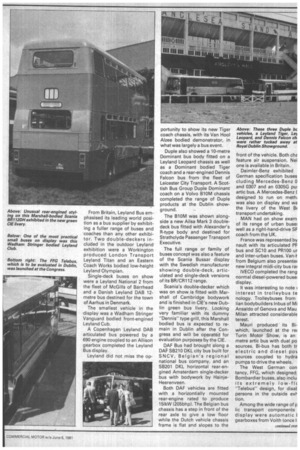Technology at expense of low-cost reliability
Page 48

Page 49

If you've noticed an error in this article please click here to report it so we can fix it.
Noel Millier finds that the key dependability factor was lost at an otherwise good show with many sophisticated buses on view
1981 International Union of ic Transport (UITP) cons and exhibition took place Neel< in Dublin. It was orgaI by a Finnish exhibition pany in co-operation with companies.
!spite political tensions reng from terrorism in NorthIreland, the Congress ated delegates from many of the world. Fifty-five exors showed the latest in fare !ction, light rail technology buses.
nurally enough, among the 1 stars of the bus and coach bition was the new range of buses from Bombardier in ion. In addition to a fleet of 'hardier coaches used to delegates around Dublin, tbardier had a dual-purpose coach and a double-decker on display.
le Bombardier family of as, to use a phrase coined cially to advertise the cles, is being -built in Shanfor the Irish State transport )pany, Coras lompair Eiin. Already, single-decker es, Expressway coaches and .s coaches have been dered and double-deck buses now in production.
E's own requirement for buses will keep Bombardier (Ireland) Ltd busy for at least nine years. However, this leaves the firm with enough spare capacity to produce export buses too. The CIE buses are powered by a type 6V-71 Detroit Diesel twostroke engine couplied to a fully automatic Allison V730 gearbox.
Full air suspension is used on the buses, which feature integral constructions using riveted aluminium body panels incorporating fibre glass mouldings. Rockwell axles are fitted on the standard CIE buses although for export Bombardier can offer Kirstall axles, and a Rolls-Royce Eagle 180 engine coupled to either the Voith D851 or ZF 4HP500 fully automatic gearboxes both incorporating a builtin retarder.
A surprise exhibit at Dublin was a Bombardier double-deck demonstrator fitted with the Rolls-Royce Eagle coupled to the optional ZF gearbox. Wheelbases used are 6.016-metre for the inter-city coach, 5.356 metres for the single-deck bus and 4.636 metres for the doubledecker. The overall length of the coach version is 11.12 metres, while the single-deck bus is 10.38 metres and the doubledeck is 9.64 metres. From Britain, Leyland Bus emphasised its leading world position as a bus supplier by exhibiting a fuller range of buses and coaches than any other exhibitor. Two double-deckers included in the outdoor Leyland exhibition were a Workington produced London Transport Leyland Titan and an Eastern Coach Works bodied low-height Leyland Olympian.
Single-deck buses on show were a Leyland National 2 from the fleet of McGills of Barrhead and a Danish Leyland DAB 12metre bus destined for the town of Aarhus in Denmark.
The smallest vehicle in the -display was a Wad ham Stringer Vanguard bodied front-engined Leyland Cub.
A Copenhagen Leyland DAB articulated bus powered by a 690 engine coupled to an Allison gearbox completed the Leyland Bus display.
Leyland did not miss the op
portunity to show its new Tiger coach chassis, with its Van Hodl Alzee bodied demonstrator, in what was largely a bus event.
Duple also showed a 10-metre Dominant bus body fitted on a Leyland Leopard chassis as well as a Dominant bodied Tiger coach and a rear-engined Dennis Falcon bus from the fleet of Leicester City Transport. A Scottish Bus Group Duple Dominant coach on a Volvo B1OM chassis completed the range of Duple products at the Dublin showground.
The B1OM was shown alongside a new Ailsa Mark 3 doubledeck bus fitted with Alexander's R-type body and destined for Strathclyde Passenger Transport Executive.
The full range or family of buses concept was also a feature of the Scania Bussar display with the Swedish manufacturer showing double-deck, articulated and single-deck versions of its BR/CR112 range.
Scania's double-decker which was on show is fitted with Marshall of Cambridge bodywork and is finished in CIE's new Dublin green bus livery. Looking very familiar with its dummy "Dennis" type grill, this Marshall bodied bus is expected to remain in Dublin after the Congress and will be operated for evaluation purposes by the CIE.
DAF Bus had brought along a DAF SB210 DKL city bus built for SNCV, Belgian's regional national bus company, and an SB201 DKL horizontal rear-engined Amsterdam single-decker bus with bodywork by HainjeHeerenveen.
Both DAF vehicles are fitted with a horizontially mounted rear-engine rated to produce 15IkW (205bhp). The Belgian bus chassis has a step in front of the rear axle to give a low floor while the Dutch vehicle chassis frame is flat and slopes to the front of the vehicle. Both che feature air suspension. Nei one is available in Britain.
Daimler-Benz exhibited German specification buses cluding Mercedes-Benz 0 and 0307 and an 0305G pu: artic bus. A Mercedes-Benz designed to run on methi was also on display and wa the livery of the West Br transport undertaking.
MAN had on show exam of its range of urban buser well as a right-hand-drive SF coach from the UK.
France was represented by nault with its articulated PF bus and SC10 and PR100 ur and inter-urban buses. Van-Ffrom Belgium also presenter new integral midi-city bus rar IVECO completed the rang normal diesel-powered buse: display.
It was interesting to note interest in trolleybus te nology. Trolleybuses from lian bodybuilders Inbus of Mi Ansaldo of Genova and Mau Milan attracted considerable terest.
Mauri produced its Biwhich, launched at the rer Turin Motor Show, is an metre artic bus with dual po sources. Bi-bus has both tr electric and diesel po‘, sources coupled to hydra pumps to drive the wheels.
The West German con tancy, FFG, which designed Bombardier buses, also inclu its extremely low-fIc "Telebus" design, for disat persons in the outside exltion.
Among the wide range of p lic transport components display were automatic gearboxes from Voith (once I












































































































